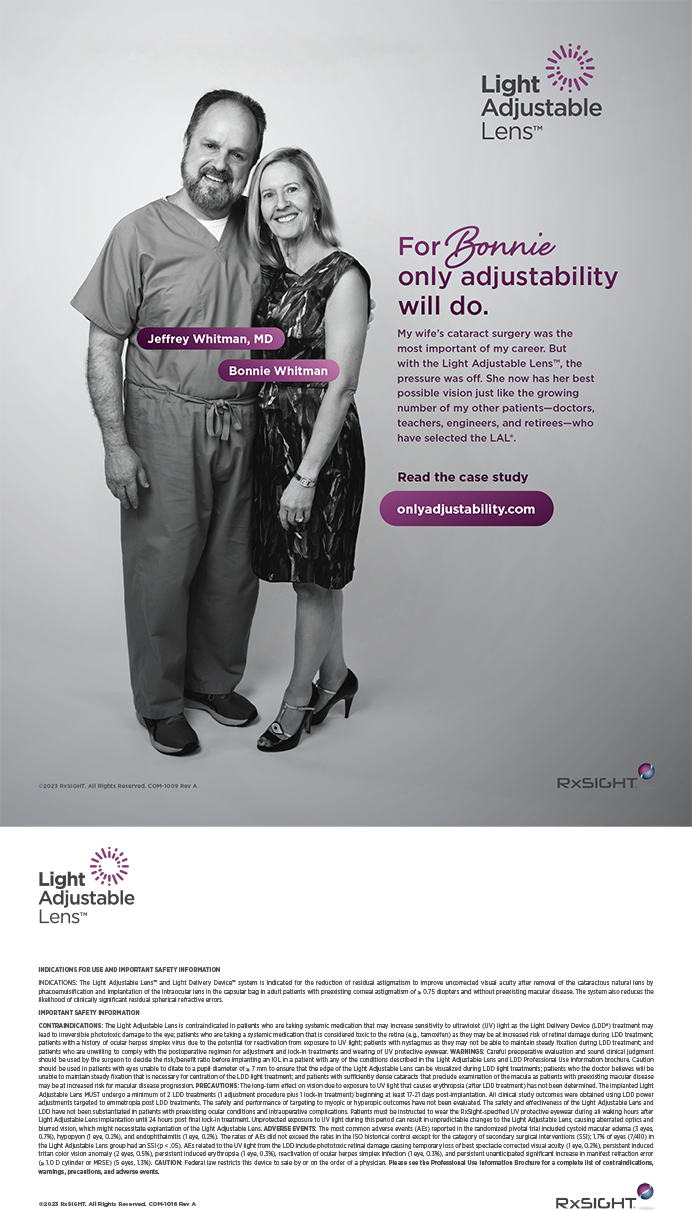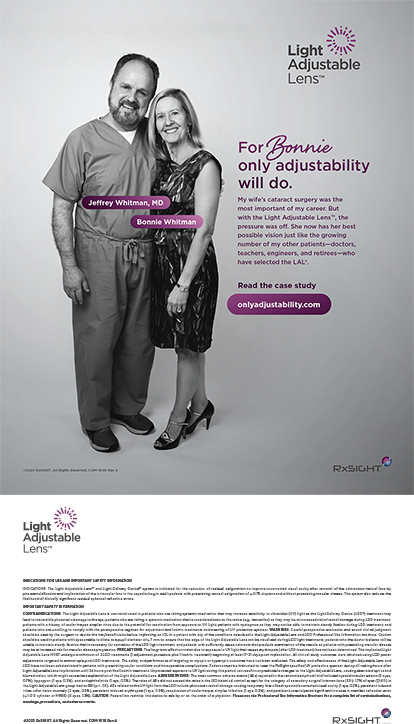| William Simcoe, MD, was undoubtedly one of the ophthalmologists who were instrumental in designing a new, better, and safer IOL at the beginning of modern cataract surgery's evolution. He and my first resident, Henry Hirschman, MD, stood staunchly against the forces relentlessly striving against the acceptance of IOL surgery. Because they believed in the lenses' value, Bill, Henry, and several other colleagues eventually won the battle. Today, cataract/IOL surgery is one of the most important and valuable operations in medicine.Bill always used his creative genius to improve his original concept for a compressible, open C-loop PCIOL in order to enhance cataract/IOL surgery's efficacy and safety. He traveled the world to teach all ophthalmologists how to use his original IOLs, instruments, and techniques and eventually became an international legend. |
| –Herve M. Byron, MD, Section Editorv |
During my residency between 1960 and1963 at what is now the Scheie Eye Institute in Philadelphia, I learned how to perform intracapsular and extracapsular cataract extraction (ICCE and ECCE). When I entered private practice, the community standard was inpatient ICCE using loupe spectacle magnification without the implantation of IOLs. As I transitioned to outpatient microsurgical ECCE with IOL implantation, senior colleagues tried unsuccessfully to revoke my medical license. My experience was typical of the battle over IOLs. Beginning in 1975, Henry Hirschman, MD, led the coalition that eventually defeated attempts to ban IOLs in the US. More struggles as well as successes were to come.
INSTRUMENTS AND TECHNIQUES
In 1983, catalogs from manufacturers such as Storz listed 27 instruments I had designed. Later, there were more. My twin-barreled I/A cannula and some other instruments are still in use today. I never requested or received compensation for them
In the 1970s, our knowledge of corneal endothelial physiology advanced rapidly.1,2 The leading cause of penetrating keratoplasty was injury from ICCE with ACIOLs or the insertion of prepupillary IOLs into a shallow anterior chamber. Some of these lenses dislocated later.
I wrote that the future would be ECCE with lens implantation in a closed system without corneal touch and with posterior capsular fixation of the IOL.3 I devised some solutions, including preplaced suture fixation of IOLs.3 Anterior chamber retaining sutures protected the corneal endothelium from prepupillary IOLs4 during and after their implantation and with corneal transplantation. Thin, temporary, transanterior chamber wires protected the corneal endothelium from IOLs if the IOP rose during their implantation.4 Also, a sterilizeable contact lens that had etched concentric rings was placed on the cornea during the wound's closure; comparing the wet area of contact with the circles indicated how much to adjust the sutures to prevent the high degree of postoperative astigmatism common at the time due to large incisions.5
A small, stainless steel ruler had curved indentations corresponding to different dioptric powers that the surgeon could match to IOLs intraoperatively5 in order to confirm the lens' power, which was often mislabeled in those days. Before Nd:YAG lasers were available, I developed a technique for a painless, leak-proof, slit-lamp posterior capsulotomy6,7 using only topical anesthesia. Surgeons continue to perform this procedure where lasers are unavailable.
ORGANIZATIONS AND PUBLICATIONS
I was on the boards of several organizations and publications, including those organized by Kenneth Hoffer, MD: the American Intra-Ocular Implant Society (AIOIS) and AIOIS Journal, which became the ASCRS and Journal of Cataract and Refractive Surgery. I observed Dani?le Aron-Rosa, MD, performing Nd:YAG laser posterior capsulotomies in Paris and prevailed upon her to publish the procedure.8
When Henry Clayman, MD, invited me in 1980 to succeed him as the editor of the AIOIS Journal, I proposed Stephen Obstbaum, MD, as a better choice. When offered the same position with Ophthalmology Times, I recommended Jack Dodick, MD. I was right both times.
I was on the permanent faculty of the Welsh Cataract/IOL Congress.
IOLs
Herve Byron, MD, and Dr. Hirschman were early IOL pioneers in the US who taught many surgeons, including myself. They encouraged me to continue developing my concept of thin, ultralight PCIOLs with easily compressible, forward angulated, open C-shaped loops implanted inside the capsular bag after ECCE, which later became the standard practice.
I implanted prototypes in animals in 1974 and in humans in 1975. I presented the patients for slit-lamp examination and showed photographic slides and a movie at the 1975 Oklahoma ophthalmology meeting. I then showed the slides and movie at two annual meetings of the AAO (Dallas 1975 and Las Vegas 1976), at the Welsh Cataract/IOL Congress in February 1977, and elsewhere. All of the manufacturers began making the lenses.
Two years after my 1975 implantations of C-loop PCIOLs in humans, someone inserted into the posterior chamber an ACIOL design used years earlier. The loops were often too short, causing disabling diplopia from the lens' displacement during horizontal saccadic eye movements (windshield wiper syndrome). Stiff, sharply curved loops ruptured the capsule and zonules, causing dislocation (sunset/sunrise syndrome), severe tissue damage, and intractable diplopia. The manufacture of those lenses was discontinued.
I implanted C-loops of various lengths as well as fully encircling loops (Figure 1) in 1979. The latter worked like today's capsular tension rings and also inhibited posterior capsular opacification. Later, others patented those designs. C-loops were adapted to foldable PCIOLs.
ETHICS AND PATENTS
I served on the Ethics Committees of the AAO and the Tulsa County Medical Society. I was taught that physicians should share all knowledge without exclusivity or profit, so I have never owned a patent. Similarly, Pierre and Marie Curie refused to patent their discovery of radium, because they felt that it belonged to all science.
In the 1970s, Frank Newell, MD, then the president of the AAO and the editor of the American Journal of Ophthalmology, wrote to me agreeing that physicians should not personally profit from their patients' misfortunes. Some who did not agree patented my shared concepts for instruments and IOLs. That cost me dearly, but I felt I should not grieve the loss of what I should never have had.
The AMA especially condemned pure method patents, which were unrelated to a patented device. Many such patents were issued for procedures already in common practice. For example, one surgeon patented a widely used cataract incision. He sued another ophthalmologist and his clinic for royalties and sought an injunction to prevent the surgeon from using, teaching, or writing about it. The legal action cost the defendants 3 years and half a million dollars, but it also led to legislation in September 1996 prohibiting the enforcement of pure method patents against physicians.
By choosing not to patent my inventions, I had no economic stake in lawsuits over IOL designs, but I was not shielded from the costly, time-consuming legal entanglements of others. My implantations in humans in 1975 of the C-loop PCIOLs I designed, however, were witnessed by a host of people who also had no financial interest in the matter. These individuals ranged from assisting hospital personnel, visiting surgeons, and people involved in IOL manufacturing. They included leaders in ophthalmology such as A. E. Maumenee, MD, Director of the Wilmer Eye Institute at Johns Hopkins University in Baltimore; Binkhorst Medalists Jan Worst, MD, Henry Hirschman, MD, Robert Drews, MD, and Norman Jaffe, MD; Blaskovics-Imre Medalist John Alpar, MD; Robert Welsh, MD, the founder of the Welsh Cataract/ IOL Congress, and Welsh faculty member Daniel Eichenbaum, MD; Herbert Gould, MD, a founder of the New York IOL Society; W. Stanley Muenzler, MD, of the Department of Ophthalmology at the University of Oklahoma; and Charles R. Moore, MD, Director of International Eye Care. I am willing to share their corroborating documentation with anyone who is interested.
PHILOSOPHY
Sir Harold Ridley told me that he wished he had invented my C-loop PCIOLs. By his request, I received the ASCRS' Innovator Award in 1989 on the 40th anniversary of his invention of the IOL. I titled my lecture "If the Truth Shall Make Us Free Why Do We Fight It So Hard?" During my talk, I quoted a passage from George Bernard Shaw's play Back to Methuselah. In it, the serpent in the Garden of Eden says, "You see things and you say Why? But I dream things that never were and I say Why Not?" That is the essence of innovation.
During my lifetime, the world's population has tripled to more than 6 billion, and it is projected to be more than 9 billion by 2050.9 Millions of patients have their cataracts removed by surgeons who have no sophisticated apparatus. In many countries worldwide, I demonstrated simple ECCE/IOL surgery using whatever was available. I served on the board of Orbis International and went on some missions.
When a serious injury abruptly ended my career in 1990, I faced the demise of my identity and my ability to do what I lived and loved to do. We cannot control what happens to us, only how we deal with it. What we are is a gift to us, and what we do with it is our gift to others. During a day spent with Muhammad Ali in 1992 (Figure 2)–our lives so different, yet our beliefs are remarkably alike–he wrote a note to me: "To Bill from Muhammad Ali. Service to others is the rent you pay for your room here on earth."
This article is adapted from a chapter in the book, The Birth of the Intraocular Lens, which will be published by Jaypee Brothers Medical Publishing in New Delhi, India.
Section Editor Herve M. Byron, MD, is Clinical Professor for the Department of Ophthalmology at the New York University School of Medicine in New York. Dr. Byron may be reached at (212) 249-8494; byronmd@mac.com.
C. William Simcoe, MD, is retired. Formerly, he was Associate Professor of Ophthalmology at the University of Oklahoma Health Sciences Center in Oklahoma City and the University of Oklahoma College of Medicine in Tulsa. He acknowledged no financial interest in the products or companies mentioned herein. Dr. Simcoe may be reached at cwsmd@cox.net.


